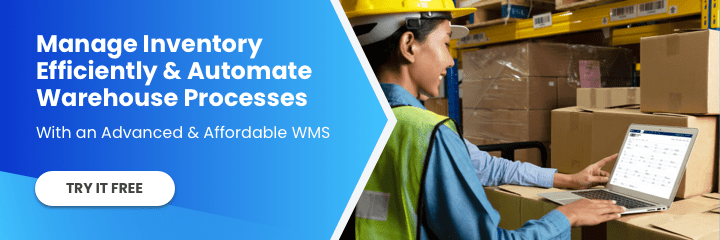If you want to learn more about Warehouse Digitalization and optimizing warehouse process, you can follow us on LinkedIn, YouTube, X, or Facebook. If you have other inquiries or suggestions, don’t hesitate to contact us here. We’ll be happy to hear from you.
Warehouse technology is an effective, sustainable, and cost-efficient solution to addressing the challenges of the warehouse. Especially now, when the market is transitioning to e-commerce platforms that are accessible and open 24/7/365, it is becoming increasingly crucial to move warehouses from relying too heavily on costly human labor into a more automated and technology-focused operation—a transition called “Warehouse Digitalization.”
Download Free Guide: Technologies That Will Transform Your Warehouse
To help you prepare for Warehouse Digitalization, we will enumerate and explain seven important warehouse technologies that you should know by 2024.
Warehouse Technologies
1. Internet of Things
The Internet of Things (IoT) is a network of interconnected physical objects that can vary from computers to non-computer objects embedded with sensors. Together, they form an ecosystem of smart items that can capture and exchange data in real-time.
This new wave of connected devices grants organizations a heightened level of visibility in every facet of the warehouse, from receiving to shipping. Additionally, IoT may vary from keeping track of machinery/infrastructure health to monitoring the movement and use of assets across the facility using sensors.
To learn more about the Internet of Things, you can read our article here.
2. Business Intelligence and Predictive Analytics
Business Intelligence is a technology that collects, analyses and presents historical and current data in a compact and easy-to-read format. This makes it simple for decision-makers to understand business data and make timely and informed decisions. On the other hand, Predictive Analytics is a technology that uses many techniques, such as statistics, data mining, predictive modeling, machine learning, and artificial intelligence, to determine patterns and trends within current data and predict possible outcomes.
As warehouses generate large amounts of data, these technologies can help analyze and convert the collected data into insights. Business Intelligence produces consolidated reports and real-time dashboards based on collected data from warehouse operations. Predictive Analytics, on the other hand, can forecast warehouse performance using historical and current data within a certain level of tolerance.
To learn more about Predictive Analytics, you can read our article here.
3. Robotics and Automation
Robotics is an interdisciplinary branch of engineering and science that deals with the design, construction, operation, and use of robots that can be programmed to perform manual processes in the warehouse. On the other hand, warehouse automation is a set of operations that can be performed autonomously with minimal or no human assistance.

Since the warehouse is filled with repeatable, process-oriented, and error-prone processes, robotics and automation are crucial technologies that help simplify operations. They can take over repetitive tasks from humans and achieve a more consistent, efficient, and accurate warehouse operation. Further, it can also improve employee engagement and retention rates as the repetitive and dull tasks are transferred to the robots, thus making warehouse personnel feel more fulfilled and efficient while tackling different operational roles.
To learn more about Robotics and Automation, you can read our article here.
4. Automated Guided Vehicles (AGVs)
Automated Guided Vehicles (AGVs) are portable machines that navigate themselves through floor stickers, radio waves, vision cameras, wires, magnets, or lasers. This technology is often used to transport raw materials, work-in-progress, and finished goods around the warehouse. Additionally, AGVs are equipped with GPS, which allows operators to direct the vehicle to the exact location where it needs to pick up or drop its cargo with utmost precision.

Warehouses equipped with AGVs are much more efficient than traditional warehouses, as they can semi-automate monotonous and time-consuming tasks and processes. Along with semi-automating warehouse processes, AGVs can work 24/7 and on demand at a consistent speed and precision since they don’t entirely depend on humans to operate.
To learn more about Automated Guided Vehicles, you can read our article here.
5. Mobile and Wearable Technologies
Mobile and Wearable Technologies refer to small computing devices worn or carried by a user to conveniently send and receive information anywhere in the warehouse. Some of the warehouse processes that benefit from these technologies are picking, packing, loading, etc.
Using mobile and wearable technologies in the warehouse increases operational efficiency since it eliminates the need to walk to a workstation, resulting in lower travel time. Additionally, accessing real-time data regardless of location allows the warehouse staff to be more agile and faster in making informed business decisions.
To learn more about Mobile and Wearable Technologies, you can read our article here.
6. Blockchain
Blockchain is a distributed digital ledger technology that records and links (or chains) blocks of transaction data from relevant parties in a verifiable and permanent manner. This technology enables respective parties to share a database of transactions, making it distributed rather than centralized. This distributed approach to data management makes this technology a preferred platform to protect data and increase accountability while making information easily accessible in a warehouse.

In the supply chain, collaboration and transparency are often limited due to the involvement of multiple entities that can intentionally manipulate the data.
Blockchain can add value by connecting these separate entities on a single platform. This makes communication easier, increases transparency, and enhances data security.
Furthermore, blockchain’s secure nature makes it nearly impossible to hack, creating a reliable source of historical data and instilling accountability among the involved parties.
To learn more about Blockchain, you can read our article here.
7. Artificial Intelligence (AI)
Artificial Intelligence (AI) is a technology that enables machines to perform human-like tasks such as decision-making, speech recognition, spatial awareness, and visual perception. AI processes massive amounts of data using machine learning algorithms and statistical models to do this.

AI is widely used in many industries, including warehousing. It is used in practices such as web-based AI chatbots. This helps companies handle customer queries with less human interaction, reducing customer support costs. Additionally, AI can semi-automate warehouse processes. For example, it can streamline the replenishment process by assigning tasks to warehouse personnel based on inventory levels and predicted demand.
To learn more about Artificial Intelligence, you can read our article here.
Which Warehouse Technologies Should You Use?
We know that scanning through these technologies can initially seem overwhelming. After all, each one promises significant potential to improve warehouse efficiency. Here’s the deal—you don’t need to adopt all the technologies available. Instead, making the right choice involves aligning the technology with your specific operational needs, goals, and budget.
Finding Your Match
Firstly, assess your current operations and identify challenges and areas needing improvement. Is your inventory management system in dire need of an overhaul? Are manual processes slowing down operations? Do you struggle with product traceability in the warehouse? Once you understand your needs, you can align them with the right technology solutions.
Considerations for Adoption
When adopting new warehouse technology, it’s important to consider a few key factors. These include how easily the technology can integrate with your current systems, how user-friendly it is, the costs involved in upkeep, and the level of support provided by the vendor. Remember, implementation may call for infrastructure and staff training changes, both of which can have financial implications and require time.
When working with AI or IoT technologies, you should be prepared for a combination of hardware and software, which could result in significant changes to processes and workflow. Assess your readiness and willingness to navigate this transition. Working with knowledgeable partners can help drive success in any such venture.
Experiment and Evolve
A wonderful aspect of technology adoption is that you can often start with smaller, manageable projects. If your main goal is to make inventory management more efficient, a solution like RFID technology may be a good starting point. Use technology to solve one specific problem, then evaluate the results before implementing the tech across other warehouse areas. This kind of experimentation allows for flexibility and reduces the risk of investment.
Just remember to keep evaluating the impact of the adopted solution. As the market and technology evolve, so should your warehouse operations. Can adjusting the tech brings better results, or should you consider something more advanced? Regular reviews can ensure your warehouse processes are efficient and evolve hand-in-hand with technological developments.
Summary
The warehouse technologies described above are helping warehouses to become more efficient, cost-effective, and productive. By incorporating these technologies into your warehouse operations, you can effectively manage the higher demands caused by e-commerce. This will, in turn, allow you to provide better service to your customers.













